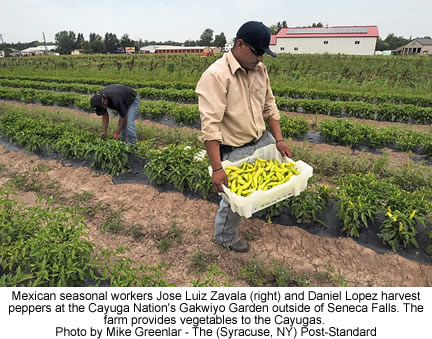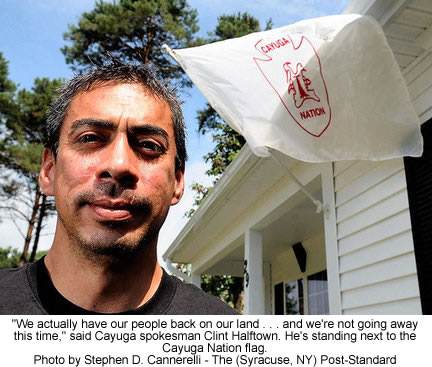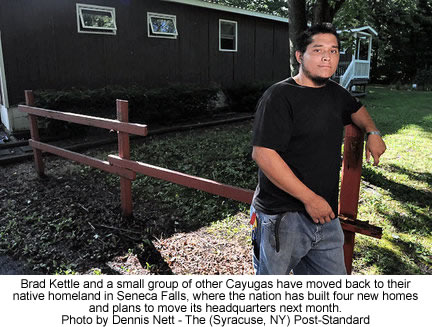 |
Canku Ota
|
 |
|
(Many Paths)
|
||
|
An Online Newsletter
Celebrating Native America
|
||
|
October 1, 2010 - Volume
8 Number 10
|
||
|
|
||
|
First Wave of Cayugas
Moves to Seneca Falls, Home of Ancestors
|
||
|
by Scott Rapp - The
(Syracuse, NY) Post-Standard
|
||
 Growing
up in Western New York, Irene Jimerson would accompany her mother,
a Cayuga Indian, to tribal meetings at local community halls. Growing
up in Western New York, Irene Jimerson would accompany her mother,
a Cayuga Indian, to tribal meetings at local community halls.
Some 20 to 30 Cayugas, most of them adults, would gather to talk about old and new business. Often discussion would turn to their ancestral homeland that encompassed 64,000 acres around the north end of Cayuga Lake. “It was always the wish — the dream — that all the people had to be able to come and settle on our own land,” Jimerson recalled. That was some 55 years ago. Today Jimerson, now 65, is among the first wave of Cayugas to return home. She and about 20 nation members have moved into houses that the nation recently acquired or built with federal grant money in Seneca Falls. It’s the first time a Cayuga Indian has lived on the nation’s aboriginal territory since the tribe fled from the area more than 200 years ago, said Clint Halftown, the nation’s federally recognized representative. The significance of his nation’s repatriation is not lost on Halftown. “This is a great day for the Cayuga nation. We actually have our people back on our land ... and we’re not going away this time,” Halftown said. Jimerson
echoed his sentiments. She and her husband, Gerald, moved into one
of four contemporary-style ranch houses that the Cayugas recently
constructed on Spruce Lane off Route 414 South on the southern edge
of the village. The nation used a $438,321 U.S. Housing and Urban Development grant available to native people to build the houses, which complement the other single-family homes on Spruce Lane, a quiet dead-end street with big trees. The back of the Jimerson’s property abuts the nation’s 100-acre commercial vegetable farm, which produces free vegetables for nation members. With the HUD money, the nation also bought four other houses, one on Spruce Lane, one on Briarwood Circle — a spur off Spruce — and two on Seneca Road. HUD has a specific block grant program for Native Americans. Nation members can rent or buy their homes from the nation. Jimerson and her husband, who is a Seneca Indian, are renting and both said they’re happy to be living in the Cayugas’ homeland. “It’s been a dream come true ... . We’re home now,” Irene Jimerson said. The couple’s two-bedroom house has cathedral ceilings, an open floor plan, two bathrooms and a full basement. The Jimersons fly the Cayugas’ red and white flag, which depicts the nation’s five clans — the heron, snipe, wolf, bear and turtle.
Nation leaders envision even bigger plans, Halftown said. “We have 64,000 acres that is Cayuga Nation territory and it’s our plan to reacquire the 64,000 acres no matter how long it takes. Our plan is to move back our people, establish businesses to help sustain us and keep going from there,” Halftown said. The
strategy includes moving the nation’s government headquarters
this fall to Seneca Falls. Those offices are in Gowanda, outside
Buffalo where many of the approximately 500 Cayugas — including
the Jimersons and Halftown — have lived for years. Halftown
said he, too, is going to move to his native homeland soon. However, the repatriation of the Cayugas is adding fuel to the fire that is the ongoing tax battle between the nation and local governments. That’s because the nation has no intention of paying taxes on the new houses and most of its other land holdings. Those properties lie within the nation’s former reservation, which Halftown said makes for sovereign tax-free territory as far as the Cayugas are concerned. “They have to understand that this is our land. We’re not paying taxes,” Halftown said. The nation’s refusal to pay taxes continues to enflame local politicians and many residents. They have tried for years to legally force the Cayugas to pay property taxes on their burgeoning empire and remit sales taxes on cigarettes sold at their lucrative LakeSide Trading stores in Union Springs and Seneca Falls. So far, the Cayugas only pay taxes on about 125 acres they have asked the federal government to place in federal trust to make them sovereign and tax-free forever. A decision is pending. “We don’t have any problem with them buying property and moving here. But it’s follow the rules and pay the taxes like everybody else. If you can’t do that we’re going to fight you with everything we have,” said county lawmaker Robert Shipley, chairman of his county’s Indian Affairs committee. Russ Wheeler, vice chairman of the Cayuga/Seneca chapter of Upstate Citizens for Equality, agreed. The group of several thousand local residents has fought the Cayugas every step of the way over the tax issues, and Wheeler said the Cayugas could wipe out Seneca Falls if the nation continues to buy property and refuse to pay taxes. “Clint Halftown is making good on his word .. . My hope is that sooner or later someone will see the fallacy of this reservation stuff,” Wheeler said. Halftown said the Cayugas are prepared to fight for what they believe is their right to have sovereign land. “We’re ready; we’re ready for it all,” Halftown said. In the village of Seneca Falls, residents pay about $50 per $1,000 assessed value in school and other property taxes, according to a local tax official. For a house assessed at $100,000, that tax bill would total $5,000.
Young, 60, acknowledged that the Cayugas’ refusal to pay taxes would put more of “the burden on the rest of us,” but said he doesn’t hold that against his new neighbors. “It’s a complicated issue,” Young said. He added he would like to develop a friendly relationship with his new neighbors. “I’d like to go over there and have a beer someday,” Young said. The
Cayugas are redeveloping their homeland and government infrastructure
as they return. It’s a work in progress, Halftown said. Those who have settled applied for housing and were given nation jobs. For example, Irene Jimerson is managing LakeSide Trading in Seneca Falls. Her adult son, Barry, moved next door with his family and was appointed head of nation security. He drives a white pickup truck with a Cayuga nation security emblem. Other Cayugas do building and grounds work, such as mowing lawns.
“I lived on the reservation my whole life so moving here was a perfect opportunity for me to start over again,” Kettle said. Like Kettle, maintenance worker Aaron Childress, who is 30, said he thought about returning to his homeland for a long time. “This is our native land. We’ve all been spread out throughout New York and throughout the country, so this is a way for everyone to come back together and start over,” Childress said. For Irene Jimerson, who had never stepped foot on her native homeland, the return home is bittersweet because her mother is no longer alive. The significance, historical and otherwise, struck her when she and her husband left Gowanda, heading east. “I remember thinking, ‘My God, I’m actually going home.’ I felt very emotional about it, but I wish my mother could have come with us,” Jimerson said. |
|
|
||
|
|
||
| Canku Ota is a free Newsletter celebrating Native America, its traditions and accomplishments . We do not provide subscriber or visitor names to anyone. Some articles presented in Canku Ota may contain copyright material. We have received appropriate permissions for republishing any articles. Material appearing here is distributed without profit or monetary gain to those who have expressed an interest. This is in accordance with Title 17 U.S.C. Section 107. | ||
|
Canku Ota is a copyright ©
2000, 2001, 2002, 2003, 2004, 2005, 2006, 2007, 2008, 2009, 2010
of Vicki Barry and Paul Barry.
|
||
 |
 |
|
|
The "Canku
Ota - A Newsletter Celebrating Native America" web site and
its design is the
|
||
|
Copyright ©
1999, 2000, 2001, 2002, 2003, 2004, 2005,
2006, 2007, 2008, 2009, 2010
of Paul C. Barry.
|
||
|
All Rights Reserved.
|
||
 Although
the Cayugas lost their federal land claim in 2005 to regain sovereign
title to their homeland, the nation now owns more than 1,100 a acres
in Cayuga and Seneca counties, some 18 houses and several small
businesses, not counting their temporarily closed Class II video
gaming facilities in Seneca Falls and Union Springs.
Although
the Cayugas lost their federal land claim in 2005 to regain sovereign
title to their homeland, the nation now owns more than 1,100 a acres
in Cayuga and Seneca counties, some 18 houses and several small
businesses, not counting their temporarily closed Class II video
gaming facilities in Seneca Falls and Union Springs. Halftown
declined to disclose the value of the nation’s new homes on
Spruce Lane, but many others on the street are assessed at about
$125,000 or more, according to property tax records. Neighbor John
“Jay” Young Jr., who lives across the street from the
Jimersons, said he and his wife, Helen, pay about $6,500 a year
on their five-bedroom ranch, which he said is assessed at about
$147,000.
Halftown
declined to disclose the value of the nation’s new homes on
Spruce Lane, but many others on the street are assessed at about
$125,000 or more, according to property tax records. Neighbor John
“Jay” Young Jr., who lives across the street from the
Jimersons, said he and his wife, Helen, pay about $6,500 a year
on their five-bedroom ranch, which he said is assessed at about
$147,000. Many
of the new settlers are young adults like Brad Kettle, who said
he is searching for a fresh start in life. Kettle, 22, was raised
on the Cattaraugus Indian Reservation, outside Buffalo, where he
said he cruised with the wrong crowd.
Many
of the new settlers are young adults like Brad Kettle, who said
he is searching for a fresh start in life. Kettle, 22, was raised
on the Cattaraugus Indian Reservation, outside Buffalo, where he
said he cruised with the wrong crowd.